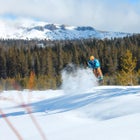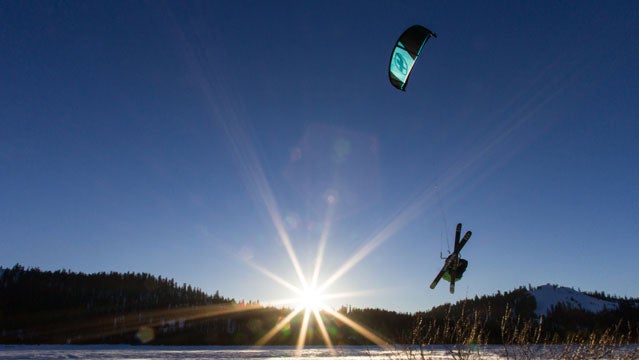The stretch across Mount St. Helens’ eastern flank for four miles before the pitch climbs 3,000 feet toward the crater. The barren flat looks more like the surface of the moon than a slice of national forest in the Pacific Northwest, and for some visitors it’s a desolate reminder of the destruction caused by the 1980 volcanic eruption.
 Derek Brown catches air through the powder at California’s first and only snowkite facility, the Sierra Snowkite Center near Truckee.
Derek Brown catches air through the powder at California’s first and only snowkite facility, the Sierra Snowkite Center near Truckee.For Aaron Sales, it’s the perfect terrain for a kite-powered summit bid.
Sales will be the first person to ascend, and ultimately descend, the volcano with a snowkite if all goes according to plan this April. He’ll need a true “sickbird” to pull it off—a day with solid snow, sunny skies, and a steady wind—but if he succeeds, he thinks he could launch the young sport to new heights and revolutionize the way we think about traversing the backcountry.
EVER TRIED TO WRESTLE an energetic pterodactyl into submission? That’s snowkiting. Get the kite to fly in the right window, and you’ve effectively harnessed a wind-powered engine that can tow skiers or snowboarders uphill and downhill. A harness wrapped around your waist anchors the kite while a control bar held horizon to the ground lets you steer it. Imagine with a small aircraft instead of dogs or horses, and you’ll start to get the idea. (Note: The kites, which resemble small paragliders, don’t mix well with trees. That’s one of the reasons why the Plains of Abraham hold such promise.)
The sport’s date of birth in the U.S. differs depending on whom you ask. A couple of Colorado skiers started using rudimentary parachutes to skip chairlift lines in the mid-1980s, dubbing the practice and, eventually, their company “.” But modern snowkiting, powered by a small group of dedicated athletes and helped by the recent backcountry craze, didn’t gain momentum until the late 1990s and early 2000s. Sales launched one of the first snowkites 15 years ago on Mount Hood after witnessing a man on waterskis get towed by a kite. He figured: if you can use a wing on water, then you can use one on snow.
“These kites really make you feel like you have superpowers,” says Sales, former editor of Kiteboarding Magazine. “It allows you to fly at a certain point and it pulls you up the mountain. It’s just this amazing power source.”
In less than two decades, the number of snowkiters in North America grew from just a handful to several thousand. Many of the western states—including Utah, Idaho, Colorado, Montana, and now California—have snowkite centers that host competitions and offer lessons. The country’s first professional snowkite tour series took flight in 2011.
The , which connects freestyle and racing events throughout the U.S., was initially about promoting the sport, says NAST co-founder Chris Nester. The first generation of U.S. snowkiters wanted a venue to showcase the kite’s potential, and they invited photographers and cinematographers to help them increase mainstream awareness.
Snowkiters need steady wind just like surfers need waves, and the kites flounder without the right recipe of elements. Three out of the four NAST stops offered subpar-at-best conditions the first year, says Nester, and there still aren’t enough competitors to swell the professional snowkiting ranks. The sport doesn’t even have an official governing body in the U.S. The unsuccessfully tried to fill that void; the group still emphasizes snowkiting’s big sister: water-based kiteboarding.
The sport’s infrastructure in the U.S. has some catching up to do. Even the great western plains don’t offer terrain like the flat, windy ice fields of Europe. Norway, home to the largest population of backcountry snowkiters in the world, hosts the each year. It’s a competition that pits more than 100 athletes against the elements on a 14-mile course that navigates through ravines and over ice fields. Compare that to the NAST courses, the longest of which was about a mile. There just aren’t snowkite sponsors in the U.S. with a large enough billfold to fund an event like the Ragnarok, says Nester. Europe boasts 12,000 snowkiters. At less than half that number, the sport’s base in the U.S. doesn’t justify that kind of money.
At the moment, it’s future as an organized sport is limited. It’s hard to grow professional races without big money, reliable winds, and enough strong competitors to catch sponsors’ attention. According to Nester, snowkiting’s biggest and most immediate potential won’t be on the world competition stage but rather will be driven by individuals looking for new ways to explore untouched terrain.
NESTER BELIEVES THERE TO be approximately the same number of kiteboarders in the Bay Area as snowkiters in the whole country, and convincing those athletes to leave the beach for the mountains—and young skiers and snowboarders to grab a kite—is perhaps snowkiting’s best chance to grow both in the backcountry and on the race course.
Tyler Brown, former NAST champion and the best overall rider at the 2012 Superfly Event in Utah, founded California’s first snowkite center in January partly to tap into the kiteboarding hotbed around San Francisco. The is located about three hours from the coast and gives lessons to people of ranging abilities, from the novice who’s never seen a kite to the broha ready to trade water for snow. It’s an easy jump to make, according to Brown. About 75 people show up each week ready to try the new sport or hone their skills.
“It’s the same thing, other than what you’re wearing on your feet and the wind that you’re dealing with,” he says. “In kiteboarding, you’re working with a constant thing. But the second you take wind into the mountains, it gets very interesting.”
Brown doesn’t think snowkiting will make an X Games appearance any time soon. Professional competitions take enormous resources to organize, and the handful of athletes driving the sport—a group that includes Sales, Nester, and Brown—needs more support before snowkiting debuts at an Olympic-caliber event. For Brown, snowkiting’s future is in the backcountry. Intrepid explorers can travel farther and faster with a kite—and a good skier or snowboarder can learn to fly a wing within several hours.
“People will have skins, a shovel, a probe, and a kite,” Brown says. “And they’ll be able to go 30-plus miles in a day versus under 10.”
“THE MOUNT ST. HELENS project is the direction we’ve been wanting to go for a long time, and finally we have the skill level, the knowledge, and the equipment to pull it off,” says Sales. “We also have the technology, which certainly helps. We’ve done the research, and now it’s time to just go for it.”
Sales hatched the plan eight years ago while riding on the back of a snowmobile over one of the volcano’s mudflats. With the right wind, the wide-open, treeless space would be perfect for snowkiting, he thought. Part of Mount St. Helens’ appeal lies in its vicinity to Sales’ backyard, but the quest is more than a Mallory-esque climb initiated “because its there.” Sales believes that if he can summit in record time, he will prove to backcountry enthusiasts nationwide that snowkiting is a legitimate power source to access killer terrain.
And that’s a huge deal. For the first time, you’ll be able to carry the chairlift with you into the wild. Forget buying expensive ski passes—an experienced skier or snowboarder could use a kite to make laps on a powder field. If Sales can summit the volcano in less than a quarter of the time it would take a skier without a kite, he could shine some new visibility on the young sport.
As revolutionary as snowkiting may be, it is limited by the wind. Sales returned to the mountain several times after the first visit, but the right recipe of conditions eluded him. He spent hours scouring Google Earth images before finding what he believes will be the route to the top: the desolate, windy plains that abut a steep 3,000-foot slope to the summit.
After pitching his tent on the flat in April, Sales will wait for a steady wind at his back (10 to 20 miles per hour is ideal), a solid, safe snowpack, and clear skies before attempting the summit. If the weather gods smile on the project and that sickbird comes together, he’ll inflate the kite and start the solo climb up the face. His route across the Plains of Abraham and up to the crater would take the average skier about four hours to skin and climb up, but Sales predicts he can do it in 45 minutes.
The route might look smooth from , but it’s actually gouged by canyons and crisscrossed with ridges. Sales will navigate over and through those obstacles as he gauges the areas with the most consistent wind—all while trying not to get blown off the side of the mountain.
He’ll have a decision to make once he nears the top—a dizzyingly thin ridge that drops several thousand feet to the Plains of Abraham on the east and into the crater on the west. Does he self-land the kite on the icy slope and risk unintended re-launch? Or does he use the wing to snowboard down the pitch and face the possibility of peeling off the side of the mountain? Some of the top snowkiters have recorded several minute-long glides more than 100 feet in the air, and Sales posited that skiers and riders could even use the wing to avoid avalanches. A jump, a quick flick of the kite, and you fly away from danger.
Don’t try that at home, though, people. Sales doesn’t know of any snowkiter who’s actually kited away from a sliding slab and said the kites shouldn’t be considered a safety net. It’s better to have the kite attached than not, he says, but leaping away from an avalanche Superman-style still only exists in the realm of backcountry yarns. Realistically, he’ll land the kite just below the summit before hiking back up to the ridge to enjoy his moment in the sun. He’ll then pack up the wing and snowboard back down to base camp. It’ll be a big step toward establishing kites as a viable method to make quick, big-mountain ascents—without the $100 lift ticket—for riders skilled enough to use them, says Sales.
“Kites are a legitimate power source to take you up incredible mountains or take you across long distances. You’re using the power of wind to reach new speeds and new heights,” he says. “It would be a benchmark in our sport to climb that high and that fast. It’s never been done.”
Axie Navas is a reporter at the Tahoe Daily Tribune, a local newspaper based in South Lake Tahoe, California.


